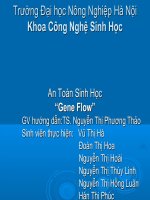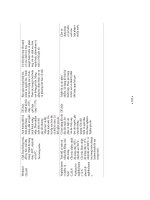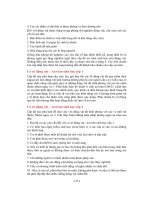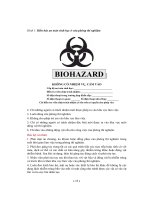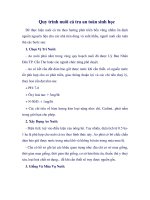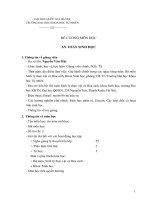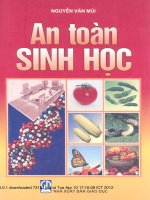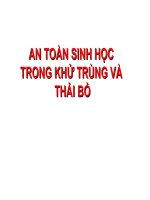An toàn sinh học tiếng Anh
Bạn đang xem bản rút gọn của tài liệu. Xem và tải ngay bản đầy đủ của tài liệu tại đây (1.44 MB, 1 trang )
<span class='text_page_counter'>(1)</span>SH03054: BIOSAFETY (AN TOÀN SINH HỌC) Credits: 2 credits (Lecture: 2 – Practice: 0) EXPECTED LEARNING OUTCOMES Course objectives. COURSE EXPECTED LEARNING OUTCOMES After successfully completing this course, students are able to. Program expected learning outcomes. K1. Understanding general introduction, history of bio-safety, biotechnology and risk issues; the general knowledge of biosafety guidelines in Biotechnology lab.. ELO3. K2. Understanding general introduction of recombinant DNA technology, gene transformation techniques. Making a risk assessment and risk management plan for genetically modified organisms. Identify and analyze the benefits and risks of genetic modifications on human, animal health and environment. Understanding, applying and implementing of testing procedures, sampling in the GMO test.. ELO3. K3. Identifying, analyzing the impact of domestic and foreign regulations related to GMO. International conventions, treaties and agreements on Bio-safety. Understand the main issues in bioethics and bioethical issues in research application of biotechnology. Ethical and social issues arising from biotechnology innovation and commercialization.. ELO3. Knowledge. Skills K4 Applying good microbiological techniques. Personal autonomy and responsibility K5. ELO10. To act professionally, lawfully, honestly and responsibly to ensure that risks and hazards are minimized, and biological ethics must be respected. Triacetylchitotriose. Diacetylchitobiose. CONTENT. STUDENT TASKS. • Chapter 1: General of bio-safety. • Attendance: Students are required to attend at least 2/3 of the total theory lectures of the course.. • Chapter 2: Laboratory Biosafety • Chapter 3: Biosafety of genetically modified organisms • Chapter 4: Risk assessment and management principles and procedures • Chapter 5: International conventions, treaties and agreements on Biosafety • Chapter 6: Bioethics: Ethical and social issues arising from biotechnology innovation and commercialization.. LEARNING METHODS • Read lecture notes, books and references before attending the class. • Students are required to listen to lectures in class and perform other learning activities such as solving practice problems after class. • Prepare and actively participate in discussion.. • Preparation for the lecture: Students are required to read lecture notes, text books and references before attending the class. • Group discussion and presentation: Students are required to engage in group discussion. • Final exam: Students must take the final exam and meet requirements. • For online learning: Students need to install online learning software and fulfill the requirements for online learning.. ELO13, ELO14, ELO15. ASSESSMENT METHODS • Attendance: According to regulations of VNUA. • Exercise and progress tests: Students must complete the exercises, 15-minute tests, group discussion and presentation with satisfied results. • Students are required to engage group work, presentation and discussion. • Final exam: Final exam is 50 minutes long with a 50-question quiz. • For online evaluation: Students need to install software and fulfill the requirements for online evaluation. • Grading: 10 marks • Weighting: Attendance: 10 % Group work: 20% Group discussion: 20% Final exam: 50%. LECTURERS 1. Dr. Đinh Trường Sơn, 0968.133.927, 2. Dr. Đặng Thị Thanh Tâm, 0944.359.567, 3. MSc. Nguyễn Thị Thuỳ Linh, 0975.553.025, 4. Assc. Prof., Dr. Nguyễn Thanh Hải, 0914.598.399,
<span class='text_page_counter'>(2)</span>

